It is estimated that 6 million car accidents occur in the United States every year. 3 Million car accidents result in injuries, with 2 million car accident injuries leaving permanent damage.
Injuries don’t always immediately present themselvesIf you’ve recently been injured in a car accident, you may be wondering how common your personal injury is and if it’s worth pursuing a claim. Injuries don’t always immediately present themselves or may initially seem minor. That doesn’t mean that damage wasn’t caused by the accident. If untreated, many types of injuries can escalate in severity or cause additional issues.We’ve identified 26 common car accident injuries below. If you’ve experienced any of them as part of your motor vehicle accident, contact us immediately to discuss the best approach to obtaining compensation for your injuries.
Common car accident injuries include:
Whiplash
Often, people with whiplash feel little or no pain after the accident—even when they have substantial injuries. This is because the body releases adrenaline and cortisol to help reduce pain and help with reactions immediately after an accident has occurred. Whiplash injuries often involve delicate soft tissue like muscles and ligaments. If you don’t treat the injury right away, a very small muscle injury risks become debilitating over time.
Broken Ribs
Generally caused by impact to the chest area during a collision, fractured or broken ribs can occur when the driver collides with the steering wheel. Passengers can also incur broken ribs when hitting with the dash, or by the force of the seatbelt during a high impact collision. Rib fractures are painful and can take months to heal.
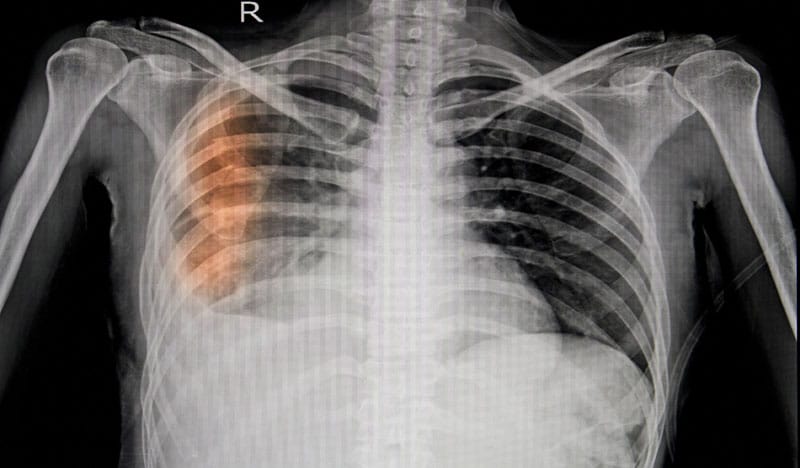
Broken ribs highlighted on x-ray highlighted in the colored area.
Internal Organ Damage
Any internal organ can be damaged in a car crash. This includes the lungs, liver, bladder, stomach, intestines and kidneys. Collisions can cause internal bleeding resulting in failure to perform essential functions. Common organ injuries caused by car accidents are liver lacerations and kidney damage. If injuries are not repaired immediately, you may suffer lasting damage or fatal internal bleeding.
Herniated Disc
During an auto accident, your spine experiences a series of forces. These forces can put pressure on the disc, causing the nucleus to push out through the disc’s fibrous exterior. This is even more common if your spine already has some age-related degeneration. The bulge is called a herniated disc or slipped disc. Sometimes, a herniated disc goes unnoticed. Other times, people report immediate and severe pain. You may also experience shooting pain into your arm or leg. Over time, the pressure on your nerves can cause muscle weakness and permanent nerve damage. Many people with herniated discs need surgery to address this injury.
Spinal Fracture
Car accidents cause 45% of all spinal fractures. Symptoms vary based on the severity and location of the injury. They include back or neck pain, numbness, tingling, muscle spasm, weakness, bowel/bladder changes, and paralysis. Paralysis is a loss of movement in the arms or legs and may also indicate a spinal cord injury.
Knee Trauma
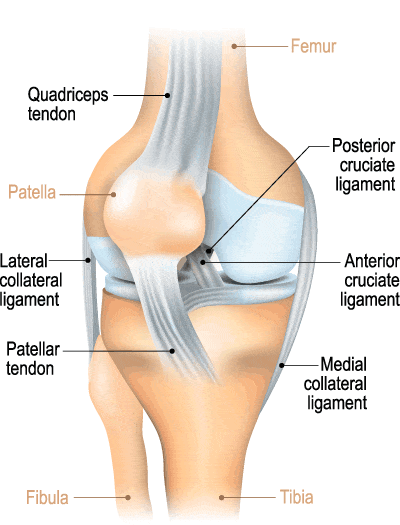
Diagram showing ligaments of the knee
Knee injuries are one of the most common forms of car accident injuries in crashes due to their proximity to the front dash. Injuries include:
- Knee Fracture: Any bone fracture is a very significant injury. A broken bone may cause deformities and discoloring, as well as an inability to use the affected limb. Knee fractures can lead to long-term issues such as arthritis.
- Knee Dislocation: If untreated, knee dislocations can lead to very serious problems. In some cases, the knee may require amputation if an arterial blockage or tear cuts off the blood supply to the lower leg.
- Knee Sprain/Strain: A knee sprain or strain occurs when you stretch, tear, or damage the ligaments, tendons, muscles, or joint capsule surrounding the knee. These types of injuries are very common in vehicle incidents.
- Torn Cartilage: Trauma can create a tear in the layer of cushioning (cartilage) in the knee. While time and rest typically heal this type of injury, surgery may be needed.
- Anterior Cruciate Ligament (ACL) Injury: The ACL the ligament that runs across the knee to give it stabilization and strength. Any damage to it is serious and requires immediate medical attention.
- Posterior Cruciate Ligament (PCL) Injury: The PCL supports and acts as a brake against certain kinds of knee motions. PCL injuries can cause instability in the joint, and depending on the severity may also require surgical repair.
- Medial Collateral Ligament (MCL) Injury: The MCL connects the tibia to the femur. MCL problems happen frequently in car crashes. If you have an MCL tear or sprain, you may feel tingling along the inside of your knee. Damage may require surgery and long-term rehab.
PTSD
According to the American Psychological Association, car accidents are the leading cause of Post-traumatic stress disorder (PTSD) among the general (non-military) population. PTSD may manifest hours after the traumatic incident, or like other car accident injuries may not be apparent for days, weeks, or even years later.
Sprains to Wrist, Neck, Back and Ankles
Sprains are caused by stretching or tearing of ligaments, the tough bands of tissue in your joints. This often happens by overextending the joint at time of impact. Sprains can cause restriction and painful limitation in a person’s range of motion. This is especially evident with back injuries.
Nerve Damage
Nerves are very delicate and can be damaged by pressure, stretching, or cutting the nerve. This can occur during the auto accident or as a result of other related injuries. Symptoms include prickling sensations, muscle pain or weakness, twitching and other uncontrolled muscle movements, numb or tingling skin or limbs, greater sensitivity of the skin to colder or warmer temperatures, and full or partial paralysis of arms, legs, fingers, or toes.
Traumatic Brain Injury
20% of all brain damage is related to vehicle accidents, according to the Center for Disease Prevention and Control. Traumatic brain injuries (TBI) happen when the head is stricken, suddenly jerked, or penetrated by a foreign object. Injuries can range from mild to severe. Mild injuries may cause headaches, confusion, dizziness, changes in mood or behavior, and trouble with memory or concentration. Severe head injuries may result in a headache that gets worse or doesn’t go away, repeated vomiting or nausea, convulsions or seizures, slurred speech, and loss of coordination. It is important to note that direct trauma to the head is not necessary to sustain a brain injury. Sudden acceleration and deceleration can cause the brain to impact the inside of the skull and injure the brain.
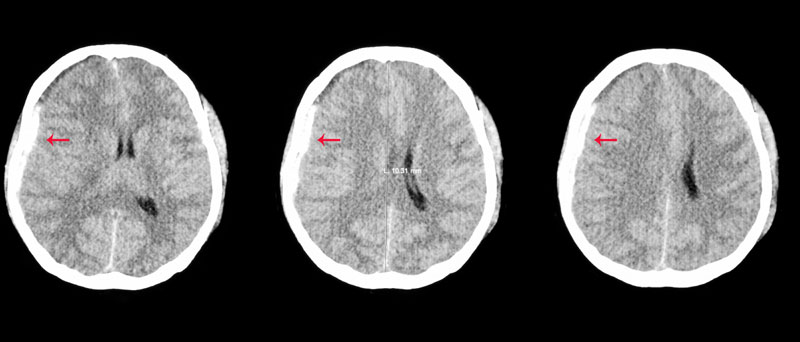
Brain CT scan of a patient with traumatic brain injury showing intracerebral bleeding and blood clots from car accident.
Concussions
As a mild form of TBI, concussions may cause you to suffer a few seconds or minutes of unconsciousness or to be dazed, confused and disoriented. It can lead to painful headaches, balance issues, and dizziness as well as personality changes, depression, anxiety, and other emotional issues. A single concussion can also make you more vulnerable to future concussions. A concussion is one type of traumatic brain injury.
Soft Tissue Injuries
Injuries to the body’s “soft” areas are considered soft tissue injuries. This includes ligaments, tendons, and muscles. Whiplash (cervical strain/sprain) is the most common soft tissue injury. Others include bruises (contusions), sprains, and strains. You may experience great pain and discomfort such as soreness, swelling, bruising, and stiffness, though some symptoms are slow to appear. If left untreated, accident victims can develop chronic pain and discomfort. Soft tissue injuries vary in severity. Some soft tissue injuries, such as a herniated disk that impinges on the nerves coming of the spine, require surgery.
Joint Dislocation
A joint dislocates when bones remain intact but are popped out of the socket and move freely. Shoulder and finger dislocations are most common, while the elbows, knees, and hips are at the greatest risk of injury and complications. Join dislocation victims experience pain and limited mobility, have an increased risk of future injuries to the joint, and may also develop early arthritis in the joint.
Internal Bleeding
After a car accident, the victim may not show any symptoms of internal bleeding, and may refuse medical assistance. Symptoms of internal bleeding can be very subtle, becoming more prominent over time. Frequent signs of internal blood loss include swelling or pain of the abdomen, dizziness or lightheadedness, a large area of skin that is turning purple, painful headache, or losing consciousness.
Mental Distress
As a part of pain and suffering damages, mental distress (also known as mental anguish or emotional distress) is when someone’s actions cause you to suffer mental harm. Mental distress after a car accident may be exhibited by feelings of humiliation/shame, insomnia, depression, self-destructive thoughts, anxiety, stress, or another emotional response. Mental health injuries can be caused directly as a result of a brain injury, or indirectly, such as PTSD.
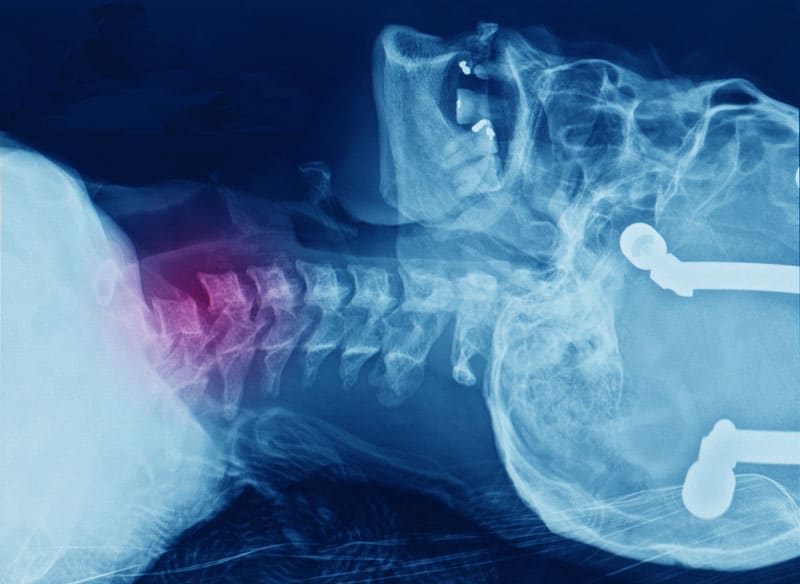
X-ray showing bilateral facet joint dislocation of C6/7 spinal level (highlighted in purple).
Paralysis or Spinal Cord Injuries
Car accidents are responsible for 46% of all spinal cord injuries in the US. A traumatic spinal cord injury may stem from impact that fractures, dislocates, crushes or compresses one or more of your vertebrae during a car crash. When the spinal cord suffers extreme damage, the result can be paralysis, the loss of function of a muscle or group of muscles. Spinal cord injuries can potentially be life-altering and the financial costs of treatment is usually very high.
Burns
Car accident burn victims often incur long-term effects, which can leave permanent scars all over the body. Burns from vehicle fires are a leading cause of severe burns in the U.S. Burn injuries can happen when two cars collide, a leaking fuel tank is present, an auto part has defects, or from smoking in or near a vehicle.
Facial Injuries and Scars
Facial injuries are another common type of injury sustained in car accidents. Injuries may include fracturing facial bones, burns, deformity, lacerations, eye damage, and injuries to facial soft tissue. Even with the best possible treatment, those with facial injuries may be left with scars that affect their appearance for the rest of their lives.
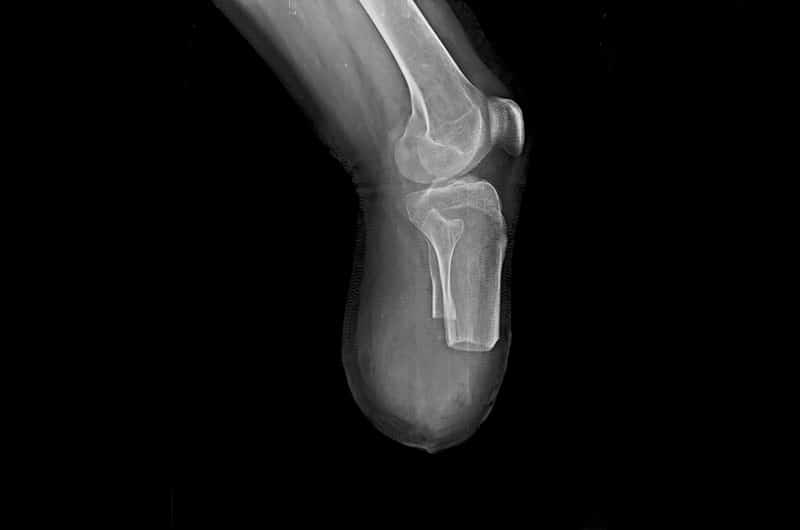
X-ray of showing bone after below-knee amputation
Limb Loss or Amputation
Sometimes serious injuries can damage the tissue beyond repair, create severe infections, or affect the blood supply to other parts of the body. In these cases, amputating the body part prevents further damage to affected body parts. Losing a limb can have devastating outcomes and complications including infections, phantom limb pain, mental health challenges and muscle weakness due to loss of mobility.
Road Rash and Lacerations
Road rash is a painful skin injury that happens when your skin makes contact with the road’s surface. Lacerations are described as any deep cut. Both motorcycle and car accident injuries can lead to extreme blood loss, scarring and disfigurement, infections, nerve damage, or potential loss of life.
Seat Belt Injuries
It is estimated that seat belts saved almost 15,000 lives in 2017. However, it can also cause serious injuries with some internal injuries not immediately apparent. Because the seat belt exerts a tremendous amount of pressure during impact, its presence can contribute to whiplash, damage to internal organs such as the liver, heart and lungs, and internal bleeding. Skin abrasions and lacerations may also occur along the chest and neck.
Crush Injuries
Crush injuries occur when a body part is wedged between two objects. It can result in bleeding, bruising, broken bones, muscle and ligament tears, nerve damage, and in extreme cases, death.
Shoulder Injuries
The shoulder joint has the greatest range of motion of any joint in the body, making it more likely to be injured. Shoulder injuries from car accidents include dislocations, major strains and sprains, complete separations, fractured bone, bruises, a torn rotator cuff, and even long-term arthritis.
Torn Rotator Cuff
The common shoulder injury, a torn rotator cuff is a stretching, tear, or rip in the tendons and ligaments in the shoulder joint. The shoulder has three separate joints, and if any of these joints disconnect, it can cause causing extreme pain and immobility. Torn rotator cuff often require surgical intervention.
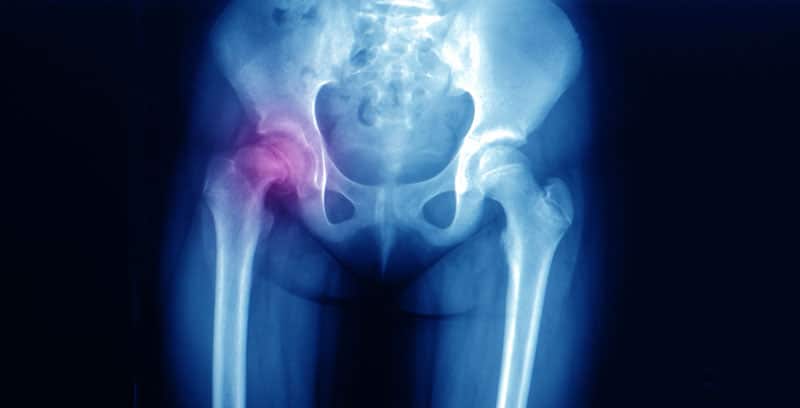
X-ray of an adolescent male patient showing slipped capital femoral epiphysis (dislocation) on right hip.
Hip Injuries
Common car accident-related hip injuries include fractures to the hip bone or hip socket, inflammation of the bursae, hip dislocation, and tendonitis. While some injuries may heal quickly and completely, others can cause long-term complications including traumatic arthritis.
Torn Labrum
This is a common shoulder injury effecting the fibrous tissue band (the labrum) that surrounds the upper arm bone socket, stabilizing the shoulder joint. The labrum can tear if your shoulder slams against a hard object inside the vehicle or you stretch your arms to brace yourself for the collision.
We always recommend seeking medical treatment as soon as you experience symptoms after an accident. This is important to do in case you have to make a claim to get medical costs paid. Some injuries don’t show up on x-rays, and if you didn’t immediately seek medical attention, insurance companies may try to dispute that your injuries were related to the car accident.
When to Contact an Accident & Injury Lawyer
Many car accident victims have a lengthy and painful road to recovery with overwhelming medical bills, loss of wages, and/or permanent disfigurement or disability. Don’t let insurance companies tell you your injuries are insignificant or try to deny they were caused by your auto accident.
If you’ve been injured in a motor vehicle accident, contact Palermo Law Group at (630) 684-2332 for a free consultation with nationally recognized personal injury lawyer, Mario Palermo, regarding the best approach to obtaining compensation for you or your loved one’s injuries.
